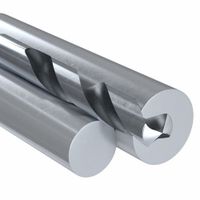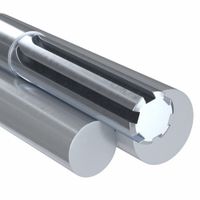Call +(254) 703 030 000 / 751 483 999 / 721 704 777
- Home
- Machining
- Drilling Holemaking
- Holemaking Blanks
.....Read More
Frequently Asked Questions
What are holemaking blanks used for?
Holemaking blanks are used as preliminary forms or starting materials in the manufacturing process of creating holes in various components. These blanks serve several purposes:
1. **Material Preparation**: Holemaking blanks are often pre-formed pieces of material that are easier to handle and manipulate during the holemaking process. They are typically made from metals, plastics, or composites, depending on the final application.
2. **Precision and Accuracy**: By starting with a blank, manufacturers can ensure that the material is uniform and consistent, which is crucial for achieving precise and accurate holes. This is especially important in industries like aerospace and automotive, where tolerances are tight.
3. **Tool Alignment**: Blanks provide a stable and predictable surface for aligning drilling or cutting tools. This helps in reducing errors and improving the quality of the hole.
4. **Customization**: Holemaking blanks can be customized to specific dimensions and shapes before the holemaking process begins. This allows for greater flexibility in manufacturing and can reduce the need for additional machining or finishing processes.
5. **Cost Efficiency**: Using blanks can be more cost-effective than starting from raw material, as they reduce waste and minimize the time spent on initial shaping and preparation.
6. **Process Optimization**: Blanks can be designed to optimize the holemaking process, such as by including features that facilitate chip removal or coolant flow, thereby improving tool life and efficiency.
7. **Versatility**: They can be used in various holemaking techniques, including drilling, reaming, tapping, and boring, making them versatile components in manufacturing.
Overall, holemaking blanks are essential in streamlining the production process, ensuring quality, and reducing costs in the manufacturing of components that require precise holes.
How do you machine holemaking blanks?
To machine holemaking blanks, follow these steps:
1. **Material Selection**: Choose the appropriate material for the blank based on the application requirements, such as strength, durability, and machinability.
2. **Design and Planning**: Create a detailed design of the hole, including dimensions, tolerances, and surface finish. Plan the machining process, selecting the appropriate tools and equipment.
3. **Workpiece Preparation**: Secure the blank material in a suitable fixture or vice to ensure stability during machining. Ensure the workpiece is clean and free from any debris or contaminants.
4. **Tool Selection**: Choose the right cutting tool based on the material and hole specifications. Common tools include twist drills, reamers, and boring bars. Consider tool material, geometry, and coating for optimal performance.
5. **Machine Setup**: Set up the machine, such as a CNC mill or lathe, with the selected tool. Input the machining parameters, including spindle speed, feed rate, and depth of cut, based on the tool and material.
6. **Drilling**: Begin with a center drill to create a pilot hole, ensuring accuracy and preventing tool drift. Follow with a twist drill to achieve the desired hole diameter. Use peck drilling for deep holes to clear chips and reduce heat.
7. **Reaming/Boring**: For precise hole dimensions and improved surface finish, use a reamer or boring tool. Reaming enlarges the hole slightly and enhances accuracy, while boring can correct alignment and size.
8. **Deburring and Finishing**: Remove any burrs or sharp edges using a deburring tool or abrasive. Apply any necessary surface treatments, such as polishing or coating, to meet the design specifications.
9. **Inspection**: Measure the hole dimensions and surface finish using appropriate gauges and instruments to ensure they meet the required tolerances and quality standards.
10. **Cleanup**: Clean the work area and maintain the machine and tools for future use.
What materials are holemaking blanks made from?
Holemaking blanks are typically made from a variety of materials, each chosen for its specific properties that suit different applications. Common materials include:
1. **High-Speed Steel (HSS):** Known for its toughness and resistance to high temperatures, HSS is widely used for general-purpose holemaking. It can withstand the heat generated during drilling and is relatively inexpensive.
2. **Cobalt Steel Alloys:** These are variations of HSS with added cobalt, enhancing their heat resistance and hardness. They are suitable for drilling harder materials like stainless steel.
3. **Carbide:** Composed of tungsten carbide particles bonded with a metal, usually cobalt, carbide blanks are extremely hard and wear-resistant. They are ideal for high-speed applications and drilling abrasive materials.
4. **Cermet:** A composite material made of ceramic and metallic materials, cermet offers high wear resistance and is used for precision holemaking in hard materials.
5. **Ceramics:** These are used for high-speed applications where heat resistance is crucial. However, they are brittle and not suitable for interrupted cuts.
6. **Polycrystalline Diamond (PCD):** Known for its extreme hardness and wear resistance, PCD is used for non-ferrous and abrasive materials. It provides excellent surface finishes and long tool life.
7. **Cubic Boron Nitride (CBN):** Second only to diamond in hardness, CBN is used for ferrous materials. It offers excellent thermal stability and wear resistance.
8. **Tool Steel:** Used for its toughness and machinability, tool steel is suitable for making custom holemaking tools.
Each material offers distinct advantages and is selected based on factors like the material being drilled, the required precision, and the operating conditions.
How do you choose the right holemaking blank for a project?
Choosing the right holemaking blank for a project involves several key considerations:
1. **Material Compatibility**: Select a blank that matches the material of the workpiece. For example, use high-speed steel (HSS) for softer materials and carbide for harder materials.
2. **Hole Specifications**: Consider the diameter, depth, and tolerance of the hole. Ensure the blank can achieve the required precision and finish.
3. **Machine Capability**: Match the blank to the capabilities of the machine tool, including spindle speed, feed rate, and power.
4. **Production Volume**: For high-volume production, choose durable materials like carbide to minimize tool wear. For low-volume, HSS may be more cost-effective.
5. **Cost**: Balance the cost of the blank with its performance and the project's budget. Higher initial costs may be justified by longer tool life and better performance.
6. **Coating**: Consider coated blanks for enhanced performance, especially in high-speed applications or when working with abrasive materials.
7. **Coolant Use**: Determine if the blank is suitable for dry machining or requires coolant. Some materials and coatings perform better with specific cooling methods.
8. **Tool Geometry**: Choose the appropriate geometry for the application, such as point angle and flute design, to optimize chip evacuation and reduce heat.
9. **Supplier Reputation**: Select blanks from reputable manufacturers to ensure quality and reliability.
10. **Environmental Conditions**: Consider the working environment, such as temperature and humidity, which may affect tool performance.
By evaluating these factors, you can select the most suitable holemaking blank for your specific project needs.
What are the benefits of using holemaking blanks?
Holemaking blanks offer several benefits in manufacturing and machining processes:
1. **Cost Efficiency**: Using holemaking blanks can reduce material waste and lower production costs. They are pre-formed to approximate dimensions, minimizing the amount of material that needs to be removed during machining.
2. **Time Savings**: Pre-formed blanks reduce the time required for machining operations. Since they are closer to the final shape, less machining is needed, speeding up the production process.
3. **Consistency and Precision**: Holemaking blanks provide consistent starting points for machining, leading to more uniform and precise final products. This consistency is crucial for maintaining quality standards in mass production.
4. **Tool Longevity**: By reducing the amount of material that needs to be cut, holemaking blanks can extend the life of cutting tools. Less wear and tear on tools means less frequent replacements and maintenance.
5. **Improved Material Properties**: Some holemaking blanks are designed to enhance specific material properties, such as strength or heat resistance, which can be beneficial for certain applications.
6. **Versatility**: Holemaking blanks can be used for a variety of applications and materials, including metals, plastics, and composites, making them versatile for different industries.
7. **Reduced Setup Time**: With holemaking blanks, the setup time for machines can be reduced, as the blanks are already aligned with the intended machining process.
8. **Enhanced Surface Finish**: Starting with a blank that is closer to the final dimensions can result in a better surface finish, as less aggressive machining is required.
9. **Customization**: Manufacturers can order holemaking blanks tailored to specific requirements, allowing for customization in the production process.
Overall, holemaking blanks streamline manufacturing processes, enhance efficiency, and improve product quality.
Can holemaking blanks be used for custom drill bits?
Yes, holemaking blanks can be used for custom drill bits. Holemaking blanks are essentially raw, unshaped pieces of material that can be machined or ground into specific shapes and sizes to create custom drill bits. These blanks are typically made from high-speed steel, carbide, or other durable materials that can withstand the rigors of drilling operations.
Using holemaking blanks for custom drill bits offers several advantages:
1. **Customization**: They allow for the creation of drill bits tailored to specific applications, including unique geometries, lengths, and diameters that may not be available in standard drill bit offerings.
2. **Material Selection**: Depending on the application, different materials can be chosen for the blanks to enhance performance, such as using carbide for increased hardness and wear resistance.
3. **Cost-Effectiveness**: For specialized applications, creating custom drill bits from blanks can be more cost-effective than modifying existing bits or purchasing specialized tools.
4. **Performance Optimization**: Custom bits can be designed to optimize performance for specific materials or conditions, such as improving chip evacuation, reducing heat generation, or enhancing cutting efficiency.
5. **Rapid Prototyping**: For industries that require rapid prototyping, using blanks allows for quick turnaround in developing and testing new drill bit designs.
However, creating custom drill bits from holemaking blanks requires precision machining and expertise in tool design to ensure the final product meets the desired specifications and performance criteria. This process often involves grinding, heat treatment, and coating to achieve the necessary cutting edge and durability. Therefore, it is typically undertaken by specialized manufacturers or skilled machinists with the appropriate equipment and knowledge.
How do you ensure precision when machining holemaking blanks?
To ensure precision when machining holemaking blanks, several key practices and considerations are essential:
1. **Material Selection**: Choose materials with consistent properties and minimal internal stresses to reduce deformation during machining.
2. **Tool Selection**: Use high-quality, sharp cutting tools appropriate for the material and hole size. Coated tools can enhance performance and longevity.
3. **Machine Calibration**: Regularly calibrate machines to ensure accuracy. Check for wear and tear in machine components that could affect precision.
4. **Workholding**: Securely clamp the workpiece to prevent movement. Use fixtures or jigs to maintain consistent positioning and alignment.
5. **Cutting Parameters**: Optimize cutting speed, feed rate, and depth of cut based on material and tool specifications to minimize tool deflection and vibration.
6. **Coolant Use**: Apply appropriate coolants or lubricants to reduce heat buildup, which can cause thermal expansion and affect precision.
7. **Tool Path Optimization**: Use CAM software to plan efficient tool paths that minimize tool engagement and reduce the risk of errors.
8. **Inspection and Measurement**: Implement in-process inspection using precision measuring tools like calipers, micrometers, or CMMs to verify dimensions and tolerances.
9. **Environmental Control**: Maintain a stable temperature and humidity in the machining environment to prevent material expansion or contraction.
10. **Operator Training**: Ensure operators are well-trained in machine operation, tool handling, and quality control procedures.
11. **Feedback Systems**: Utilize advanced feedback systems like CNC machine sensors to monitor and adjust machining parameters in real-time.
12. **Post-Processing**: Perform deburring and finishing operations to remove any residual material that could affect the hole's precision.
By integrating these practices, precision in machining holemaking blanks can be significantly enhanced, leading to high-quality, accurate components.


